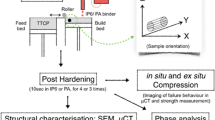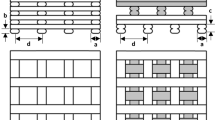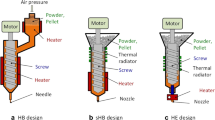Abstract
The post-processing treatment plays an important role in tailoring the mechanical and biological properties of the three-dimensional powder-printed porous scaffolds. Depending on scaffold material composition, a combination of post-processing treatments can be used to tailor these properties. This work probes into the impact of post-processing on the microstructure and deformation behavior of 3D-printed scaffolds. In this study, we have chosen CaSO4·xH2O (POP), a system for 3D powder printing and two different post-processing methodologies, namely chemical conversion and polymer infiltration. POP-based scaffolds were fabricated using water-based binder with up to 55% interconnected microporosity and moderate compressive strength of 1.5 MPa. Microcomputed tomography (µCT) is extensively utilized to determine the accuracy and efficacy of the adopted printing and post-processing approach. It was shown that the reproducibility of the fine features depends not only on the size but also on the presence of neighboring features. Crucially, µCT-based microstructure modeling and finite elemental simulation were attempted to computationally capture the compression behavior, in silico. Finally, in situ compression coupled with µCT imaging provided us an insight into fracture behavior of 3D powder-printed scaffolds.








Similar content being viewed by others
References
A. Bandyopadhyay, B. Krishna, W. Xue, and S. Bose: Application of laser engineered net shaping (LENS) to manufacture porous and functionally graded structures for load bearing implants. J. Mater. Sci.: Mater. Med. 20, 29 (2009).
B. Basu: Biomaterials Science and Tissue Engineering: Principles and Methods (Cambridge University Press, Cambridge, UK, 2017).
B. Basu: Biomaterials for Musculoskeletal Regeneration: Concepts (Springer, New York, 2016).
A. Kumar, S. Mandal, S. Barui, R. Vasireddi, U. Gbureck, M. Gelinsky, and B. Basu: Low temperature additive manufacturing of three dimensional scaffolds for bone-tissue engineering applications: Processing related challenges and property assessment. Mater. Sci. Eng., R 103, 1 (2016).
S. Barui, S. Chatterjee, S. Mandal, A. Kumar, and B. Basu: Microstructure and compression properties of 3D powder printed Ti–6Al–4V scaffolds with designed porosity: Experimental and computational analysis. Mater. Sci. Eng., C 70, 812 (2017).
S. Barui, S. Mandal, and B. Basu: Thermal inkjet 3D powder printing of metals and alloys: Current status and challenges. Curr. Opin. Biomed. Eng. 2, 116–123 (2017).
A. Farzadi, V. Waran, M. Solati-Hashjin, Z.A.A. Rahman, M. Asadi, and N.A.A. Osman: Effect of layer printing delay on mechanical properties and dimensional accuracy of 3D printed porous prototypes in bone tissue engineering. Ceram. Int. 41, 8320–8330 (2015).
S. Meininger, S. Mandal, A. Kumar, J. Groll, B. Basu, and U. Gbureck: Strength reliability and in vitro degradation of three-dimensional powder printed strontium-substituted magnesium phosphate scaffolds. Acta Biomater. 31, 401 (2016).
E. Vorndran, M. Klarner, U. Klammert, L.M. Grover, S. Patel, J.E. Barralet, and U. Gbureck: 3D powder printing of β-tricalcium phosphate ceramics using different strategies. Adv. Eng. Mater. 10, B67 (2008).
K. Lu, M. Hiser, and W. Wu: Effect of particle size on three dimensional printed mesh structures. Powder Technol. 192, 178 (2009).
A. Butscher, M. Bohner, C. Roth, A. Ernstberger, R. Heuberger, N. Doebelin, P. Rudolf von Rohr, and R. Müller: Printability of calcium phosphate powders for three-dimensional printing of tissue engineering scaffolds. Acta Biomater. 8, 373 (2012).
S. Tarafder, V.K. Balla, N.M. Davies, A. Bandyopadhyay, and S. Bose: Microwave-sintered 3D printed tricalcium phosphate scaffolds for bone tissue engineering. J. Tissue Eng. Regener. Med. 7, 631 (2013).
Z. Zhou, E. Cunningham, A. Lennon, H.O. McCarthy, F. Buchanan, S.A. Clarke, and N. Dunne: Effects of poly(ε-caprolactone) coating on the properties of three-dimensional printed porous structures. J. Mech. Behav. Biomed. Mater. 70, 68–83 (2017).
U. Gbureck, E. Vorndran, F.A. Müller, and J.E. Barralet: Low temperature direct 3D printed bioceramics and biocomposites as drug release matrices. J. Controlled Release 122, 173 (2007).
M. Asadi-Eydivand, M. Solati-Hashjin, A. Farzad, and N.A.A. Osman: Effect of technical parameters on porous structure and strength of 3D printed calcium sulfate prototypes. Robot. Comput. Integrated Manuf. 37, 57 (2016).
J. Suwanprateeb, F. Thammarakcharoen, K. Wasoontararat, and W. Suvannapruk: Influence of printing parameters on the transformation efficiency of 3D-printed plaster of paris to hydroxyapatite and its properties. Rapid Prototyp. J. 18, 490 (2012).
M. Dziadek, E. Stodolak-Zych, and K. Cholewa-Kowalska: Biodegradable ceramic-polymer composites for biomedical applications: A review. Mater. Sci. Eng., C 71, 1175 (2017).
R. Lowmunkong, T. Sohmura, J. Takahashi, Y. Suzuki, S. Matsuya, and K. Ishikawa: Transformation of 3DP gypsum model to HA by treating in ammonium phosphate solution. J. Biomed. Mater. Res., Part B 80, 386 (2007).
R. Lowmunkong, T. Sohmura, Y. Suzuki, S. Matsuya, and K. Ishikawa: Fabrication of freeform bone-filling calcium phosphate ceramics by gypsum 3D printing method. J. Biomed. Mater. Res., Part B 90B, 531 (2009).
M. Asadi-Eydivand, M. Solati-Hashjin, S.S. Shafiei, S. Mohammadi, M. Hafezi, and N.A.A. Osman: Structure, properties, and in vitro behavior of heat-treated calcium sulfate scaffolds fabricated by 3D printing. PLoS One 11, e0151216 (2016).
M.L. Bouxsein, S.K. Boyd, B.A. Christiansen, R.E. Guldberg, K.J. Jepsen, and R. Müller: Guidelines for assessment of bone microstructure in rodents using micro-computed tomography. J. Bone Miner. Res. 25, 1468 (2010).
D. Sarkar, S. Mandal, B. Reddy, N. Bhaskar, D. Sundaresh, and B. Basu: ZrO2-toughened Al2O3-based near-net shaped femoral head: Unique fabrication approach, 3D microstructure, burst strength and muscle cell response. Mater. Sci. Eng., C 77, 1216 (2017).
D. Sarkar, B. Sambi Reddy, S. Mandal, M. RaviSankar, and B. Basu: Uniaxial compaction-based manufacturing strategy and 3D microstructural evaluation of near-net-shaped ZrO2-toughened Al2O3 acetabular socket. Adv. Eng. Mater. 18, 1634–1644 (2016).
K. Hammonds and I. Baker: Quantifying damage in polycrystalline ice via X-ray computed micro-tomography. Acta Mater. 127, 463–470 (2017).
J. Réthoré, N. Limodin, J-Y. Buffière, S. Roux, and F.c. Hild: Three-dimensional analysis of fatigue crack propagation using X-ray tomography, digital volume correlation and extended finite element simulations. Procedia IUTAM 4, 151 (2012).
N. Limodin, J. Rethore, J-Y. Buffiere, F. Hild, S. Roux, W. Ludwig, J. Rannou, and A. Gravouil: Influence of closure on the 3D propagation of fatigue cracks in a nodular cast iron investigated by X-ray tomography and 3D volume correlation. Acta Mater. 58, 2957 (2010).
N. Limodin, L. Salvo, E. Boller, M. Suéry, M. Felberbaum, S. Gailliègue, and K. Madi: In situ and real-time 3-D microtomography investigation of dendritic solidification in an Al–10 wt% Cu alloy. Acta Mater. 57, 2300 (2009).
N. Limodin, L. Salvo, M. Suéry, and M. DiMichiel: In situ investigation by X-ray tomography of the overall and local microstructural changes occurring during partial remelting of an Al–15.8 wt% Cu alloy. Acta Mater. 55, 3177 (2007).
H.A. Bale, A. Haboub, A.A. MacDowell, J.R. Nasiatka, D.Y. Parkinson, B.N. Cox, D.B. Marshall, and R.O. Ritchie: Real-time quantitative imaging of failure events in materials under load at temperatures above 1600 °C. Nat. Mater. 12, 40 (2013).
S.A. McDonald, G. Dedreuil-Monet, Y.T. Yao, A. Alderson, and P.J. Withers: In situ 3D X-ray microtomography study comparing auxetic and non-auxetic polymeric foams under tension. Phys. Status Solidi B 248, 45 (2011).
C. Petit, S. Meille, and E. Maire: Cellular solids studied by X-ray tomography and finite element modeling—A review. J. Mater. Res. 28, 2191 (2013).
J-W. Cao and M. Sakai: Crack-face fiber bridging: Finite element analysis, analytical model, and experimental result. J. Mater. Res. 11, 1537 (1996).
L. Zhang, J.M. Ferreira, S. Olhero, L. Courtois, T. Zhang, E. Maire, and J.C. Rauhe: Modeling the mechanical properties of optimally processed cordierite–mullite–alumina ceramic foams by X-ray computed tomography and finite element analysis. Acta Mater. 60, 4235 (2012).
N. Michailidis, F. Stergioudi, H. Omar, D. Papadopoulos, and D. Tsipas: Experimental and FEM analysis of the material response of porous metals imposed to mechanical loading. Colloids Surf., A 382, 124 (2011).
C. D’Angelo, A. Ortona, and P. Colombo: Finite element analysis of reticulated ceramics under compression. Acta Mater. 60, 6692 (2012).
S.C. Cox, J.A. Thornby, G.J. Gibbons, M.A. Williams, and K.K. Mallick: 3D printing of porous hydroxyapatite scaffolds intended for use in bone tissue engineering applications. Mater. Sci. Eng., C 47, 237 (2015).
W. Xue, A. Bandyopadhyay, and S. Bose: Polycaprolactone coated porous tricalcium phosphate scaffolds for controlled release of protein for tissue engineering. J. Biomed. Mater. Res., Part B 91, 831 (2009).
V. Vega, J. Clements, T. Lam, A. Abad, B. Fritz, N. Ula, and O.S. Es-Said: The effect of layer orientation on the mechanical properties and microstructure of a polymer. J. Mater. Eng. Perform. 20, 978 (2011).
M. Castilho, C. Moseke, A. Ewald, U. Gbureck, J. Groll, I. Pires, J. Teßmar, and E. Vorndran: Direct 3D powder printing of biphasic calcium phosphate scaffolds for substitution of complex bone defects. Biofabrication 6, 015006 (2014).
M. Castilho, M. Dias, U. Gbureck, J. Groll, P. Fernandes, I. Pires, B. Gouveia, J. Rodrigues, and E. Vorndran: Fabrication of computationally designed scaffolds by low temperature 3D printing. Biofabrication 5, 035012 (2013).
S. Mandal, S. Meininger, U. Gbureck, and B. Basu: 3D powder printed tetracalcium phosphate scaffold with phytic acid binder: Fabrication, microstructure and in situ X-ray tomography analysis of compressive failure. J. Mater. Sci.: Mater. Med. 29, 29 (2018).
L. Vincent and P. Soille: Watersheds in digital spaces: An efficient algorithm based on immersion simulations. IEEE Trans. Pattern Anal. Mach. Intell., 13, 583–598 (1991).
H-C. Hege, D. Stalling, M. Seebass, and M. Zockler: A Generalized Marching Cubes Algorithm Based on Non-binary; Technical Report No. SC-97-05 (Konrad-Zuse-Zentrum (ZIB), Berlin, 1997).
M. Zilske, H. Lamecker, and S. Zachow: Adaptive remeshing of non-manifold surfaces. Eurographics 27, 1–7 (2008). (short papers).
R. Löhner and P. Parikh: Generation of three-dimensional unstructured grids by the advancing-front method. Int. J. Numer. Methods Fluids 8, 1135 (1988).
H. Jin and R. Tanner: Generation of unstructured tetrahedral meshes by advancing front technique. Int. J. Numer. Meth. Eng. 36, 1805 (1993).
H. Jin and N-E. Wiberg: Two-dimensional mesh generation, adaptive remeshing and refinement. Int. J. Numer. Meth. Eng. 29, 1501 (1990).
M. Castilho, B. Gouveia, I. Pires, J. Rodrigues, M. Pereira, R.I. Campbell, and R.I. Campbell: The role of shell/core saturation level on the accuracy and mechanical characteristics of porous calcium phosphate models produced by 3D printing. Rapid Prototyp. J. 21, 43–55 (2015).
Z. Zhou, F. Buchanan, C. Mitchell, and N. Dunne: Printability of calcium phosphate: Calcium sulfate powders for the application of tissue engineered bone scaffolds using the 3D printing technique. Mater. Sci. Eng., C 38, 1 (2014).
A. Farzadi, M. Solati-Hashjin, M. Asadi-Eydivand, and N.A.A. Osman: Effect of layer thickness and printing orientation on mechanical properties and dimensional accuracy of 3D printed porous samples for bone tissue engineering. PLoS One 9, e108252 (2014).
G. Vekinis, M. Ashby, and P. Beaumont: Plaster of paris as a model material for brittle porous solids. J. Mater. Sci. 28, 3221 (1993).
P. Coquard, R. Boistelle, L. Amathieu, and P. Barriac: Hardness, elasticity modulus and flexion strength of dry set plaster. J. Mater. Sci. 29, 4611 (1994).
K.K. Phani, S. Niyogi, A. Maitra, and M. Roychaudhury: Strength and elastic modulus of a porous brittle solid: An acousto-ultrasonic study. J. Mater. Sci. 21, 4335 (1986).
ACKNOWLEDGMENTS
The authors acknowledge the financial support provided by Department of Science and Technology, Government of India and Department of Biotechnology, Government of India under different research grants to carry out research activities. S. Mandal would like to thank Dr. Alok Kumar, for his encouragement at the starting of this study, Barthi R, for her assistance in acquiring XRD and SEM data, and Dr. Subhomoy Chatterjee, for earnestly extending help in the finite elemental analysis related procedures. We also thank the anonymous reviewers for their constructive criticism in improving the quality of the manuscript and the study.
Author information
Authors and Affiliations
Corresponding author
Supplementary
Rights and permissions
About this article
Cite this article
Mandal, S., Basu, B. Probing the influence of post-processing on microstructure and in situ compression failure with in silico modeling of 3D-printed scaffolds. Journal of Materials Research 33, 2062–2076 (2018). https://doi.org/10.1557/jmr.2018.188
Received:
Accepted:
Published:
Issue Date:
DOI: https://doi.org/10.1557/jmr.2018.188




